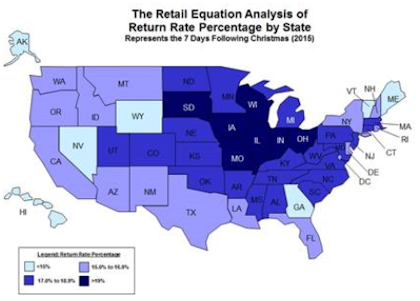THE RETAIL EQUATION PRESENTS:
A TALE OF HOLIDAY RETURNS
The Retail Equation Releases Stats Revealing Volume of 2015 Holiday Returns
 With return authorization solutions deployed in 34,000 stores across the
country, The Retail Equation, an Appriss company, annually reports on the state
of post-holiday returns in the United States. The company is uniquely positioned
to paint an accurate picture through the vast amounts of data it collects and
analyzes during the seven days after Christmas at the point of return. This data
reveals some compelling facts about consumer return behavior.
With return authorization solutions deployed in 34,000 stores across the
country, The Retail Equation, an Appriss company, annually reports on the state
of post-holiday returns in the United States. The company is uniquely positioned
to paint an accurate picture through the vast amounts of data it collects and
analyzes during the seven days after Christmas at the point of return. This data
reveals some compelling facts about consumer return behavior.
TOP FIVE FACTS
ABOUT 2015 HOLIDAY RETURNS
1. Returns peaked again on Dec. 26 at 11:15 a.m. PST/2:15 p.m. EST., this is the
same time returns peaked last year. It's clear lunchtime on the day after
Christmas is the most popular return time of the entire year. This is when all
return registers should be properly staffed and associates should be ready to
deliver the best customer experience. It is also the ideal time to convert gift
returners into regular shoppers.
2. The highest rate of returns nationwide occurred on Dec. 26, where returns
were more than two times the normal rate seen during the holiday season. And,
interestingly, because of the way Saturdays fell in relation to both Christmas
and New Year's Day, Jan. 2 was a big return day also with returns nearly double
the normal rate.
3. The Midwest states again had the highest rate of returns, when comparing
total dollars purchased to total dollars returned and exchanged.
4. Illinois had the highest rate of returns with 21.6 percent, while Missouri
had the second highest at 21.3 percent.
5. The state with the least rate of returns was Vermont with 12.2 percent.
"Every year, we aim to offer key insights on return behavior to help retailers
optimize their return counter and create a positive shopping experience for
their consumers," said David Speights, chief data scientist at The Retail
Equation. "This might include incorporating friendly return practices that still
allow for managing risk and preventing invalid returns to staffing up during
certain days and times."
As the hustle and bustle of the holidays begins to wind down, retail executives
turn their attention to final shrink numbers. The Retail Equation has conducted
studies to substantiate the fact that return rate and return fraud are closely
tied to shrink. These studies indicate that if a retailer takes actions to
prevent return fraud and abuse, shrink can be reduced by a significant amount.
This suggests that paying close attention to returns is a powerful weapon to
combat shrink. As companies look to improve their loss prevention metrics in the
coming months, they should consider implementing strategies to reduce return
rate and fraud and, ultimately, shrink.
 About
The Retail Equation
About
The Retail Equation
The Retail Equation, an Appriss company, optimizes retailers' revenue and margin
by shaping behavior in every customer transaction. The company's solutions use
predictive analytics to turn each individual shopper visit into a more
profitable experience. This yields immediate financial payback, increasing store
comps by as much as two percent, with significant return on investment. The
Software-as-a-Service applications operate in more than 34,000 stores in North
America, supporting a diverse retail base of specialty apparel, footwear, hard
goods, department, big box, auto parts, and more. For more information, visit
www.theretailequation.com.